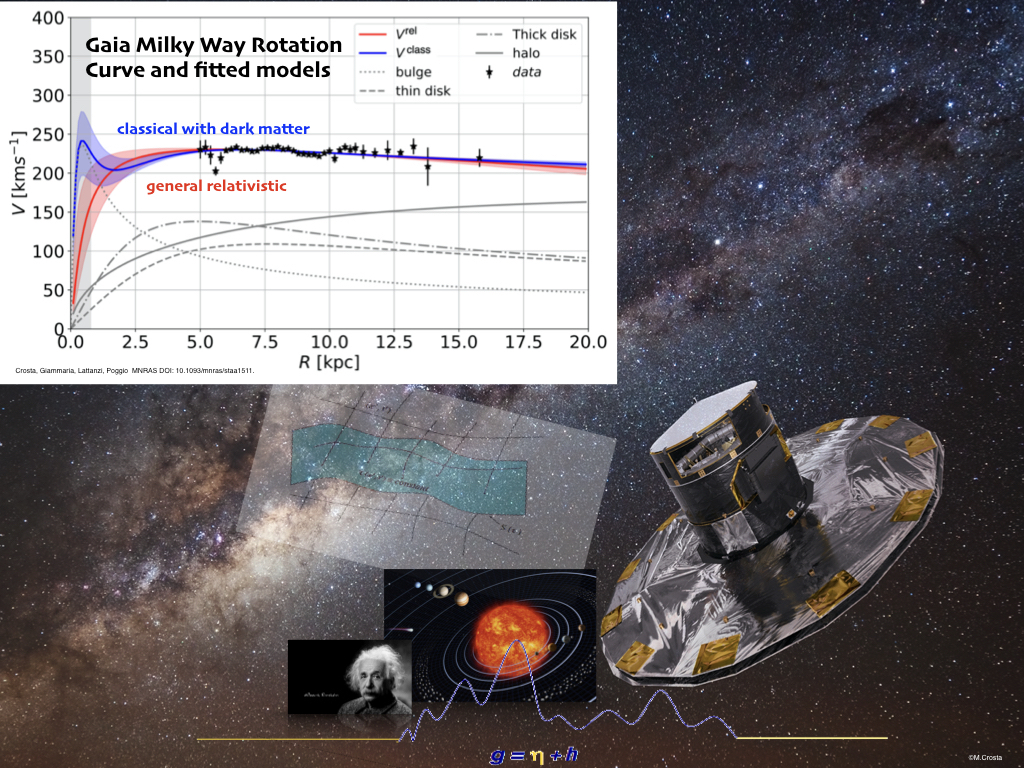IoW_20200716 - Gaia
Image of the Week |
Testing CDM and geometry-driven Milky Way rotation Curve Models
|
|
|
|
A plot of the Gaia Milky Way rotation curve and fitted models is shown in this figure, where the azimuthal velocity profile of the Milky Way as derived from a sample of disc tracers from Gaia DR2 is given. Image credit: M.Crosta, M.Giammaria, M.G.Lattanzi, E.Poggio MNRAS, Volume 496, Issue 2, August 2020. |
| The work "on testing CDM and geometry-driven Milky Way rotation curve models with Gaia DR2" demonstrates for the first time, thanks to the large scale, highly accurate mapping of stellar distances and velocities enabled by the ESA Gaia mission, that the observed flatness of the Milky Way rotation curve can have a general relativistic origin, not predictable from Newtonian gravity. The study suggests that the underlying geometry drives the stellar velocities in the plane of our Galaxy away from its center consistently with Einstein’s theory. Indeed, given the gravitational sources and an underlying geometry, “space tells matter how to move, matter tells space how to curve” (J.A. Wheeler). In this respect, geometry, as manifestation of gravity, would tackle the gravitational properties of Dark Matter (DM). The investigation also shows that one of Einstein’s equations provides the necessary baryonic matter density in a self-consistent way. Then, no additional extra matter is required, while the relativistic velocity profile results statistically indistinguishable from its state-of-the-art DM-based analogue, introduced to account for the gap between the observed rotation curve and the expected Newtonian velocities, after the historical observations of Zwicky and Vera Rubin. This dark matter is supposed to reside mostly in the Galactic halo, whereas the relativistic dragging velocity in the disk can effectively compensate for its absence. By utilizing Gaia DR2 products (parallaxes to better than 20% and the complete set of proper motions and line-of-sight velocities) and the complement of 2MASS photometry, we were able to select a very homogenous sample of 5602 disk stars (5277 UMS stars and 325 classical type I Cepheids), and then reconstruct the kinematics of the axisymmetric part of the Galactic potential over a large range (from 5 to 16 kpc) of galactocentric distances. Two models, one general relativity and a DM-based analogue, were fit to these unprecedented Galactic rotation curve data, and the results have shown for the first time that a general relativity model is able to represent the experimental data with a quality in all similar to that of a traditional model based on Newtonian dynamics and a dark matter halo. In the light of these results, future Galactic model should be developed consistently with the data delivered by Gaia. Indeed, it was crucial that we correctly framed the velocity measurement made by the observer at rest with the Solar System (BCRS) and the one at rest with the center of the Galaxy. Contrary to classical astronomy, the measurement process in general relativity depends on the underlying geometry and such a velocity turns out to be proportional to the off-diagonal term of the metric related to the gravitational dragging. The only general relativity model that allowed us to apply the above first principles was a (simplified) general relativistic dust model, axisymmetric and stationary. For this case an appropriate velocity profile was proposed in recent years by Balasin and Grummiller (2008). Despite some inadequacies and incompleteness (e.g., it cannot be extended, as is, to the inner regions of the Milky Way), this model has proven to be quite useful for demonstrating the relativistic nature of the Gaia-mapped rotation curve from within our Milky Way, allowing also to estimate the (external) radial size of the Galactic bulge and the disc thickness at radial distances R>4 kpc. These encouraging initial results call for the thorough use of Einstein’s theory in the years to come, and state the need to develop more complex relativistic galactic “geometries” that can take into proper account the various structures of the Galaxy. This also in anticipation of the incoming and increasingly accurate new Gaia data releases and, possibly, of other observations targeting the Galaxy central regions. Finally, a proper general relativity representation of the Milky Way, as depicted by the Gaia-like relativistic observer, can help putting to test, at the Galactic scale, the predictions of any cosmological model of our Galaxy. This study resulted from the research activities of the INAF-OATo team working on gravitational astrometry and its testing at the local and Galactic scale. This is a multidisciplinary group of scientists bringing together crucial expertise that has helped “gluing” together critical aspects, from theory to testing. Also, this work is part of the research activities of M. Giammaria toward his Phd in Physics with the University of Torino (M. Crosta and M. G. Lattanzi advisors). The program is funded by INAF and supported by ASI through contract 2014-025-R.1.2015.
|
|
Credits: M. Crosta, M. Giammaria,M.G. Lattanzi, E. Poggio [Published: 16/07/2020] |
- Removed a total of (5) style text-align:center;
- Removed a total of (14) style text-align:justify;
- Removed a total of (1) border attribute.
- Removed a total of (1) cellpadding attribute.
- Removed a total of (1) cellspacing attribute.
Image of the Week Archive
- Removed a total of (1) border attribute.
- Removed a total of (1) cellpadding attribute.
- Removed a total of (1) cellspacing attribute.








































 Sign in
Sign in
 Science & Technology
Science & Technology
